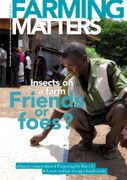With the Rio+20 conference coming up, it is time to evaluate what a “green economy” really means. Is this addressed in discussions throughout the world? Is a truly “green” economy viable in different regions? What are the main barriers in different countries? Network colleagues shared some of their opinions.
T.M. Radha: “A gradual process”

However, as India is already facing the impacts of climate change, more prominently on the livelihoods and health of the people, the efforts towards “greening” the economy are gaining significance.
Water conservation, renewable energy, converting waste into energy and protecting land from degradation are some of the priority areas. In countries like India, with a huge population, any investment is expected to generate local employment.
Heavy investments are being made in the name of a “green economy”, especially in the private sector. Yet, many fear that those “greening” the economy may end up controlling it completely, leaving local people clueless and unable to access the benefits.
But India has another side too. For thousands of years it has been a land of recycling and resource conservation. Nothing is wasted, everything is re-used or recycled. Traditional Indian agriculture is the best example of this principle. Living simply is also part of the culture, even if this has been seriously affected by exposure to western cultures and domestic commercial interests. So most efforts only require “going back” to traditional cultures and practices.
According to T.M. Radha, “a ‘green economy’ driven by a prescriptive global development model may not be viable for a country like India. We can only be green if we follow our own development priorities. In developing countries like ours, the transition to a ‘green economy’ is essentially a gradual and a time consuming process.”
Anthony Mugo: “It needs to make economic sense to ordinary Kenyans”

But, it is even more important to recognise that a truly “green economy” can only be viable if the public is conscious of what it means. “Discussions on ‘greening the economy’ should focus on ‘green’ options that make economic sense to the ordinary Kenyans.”
The private sector in Kenya is promoting environmentally friendly practices; many non-state actors are promoting the adoption of alternative energy sources, and the government has taken steps to monitor the environment. Since climate change is already having a negative impact on Kenya’s economic sectors (such as agriculture, or wildlife and tourism), the government is calling for a sustained national effort to reduce the emission of greenhouse gases.
The Ministry of Environment and Mineral Resources is also developing an action plan for implementing the National Climate Change Response Strategy (NCCRS). According to the NCCRS, the adoption of low-carbon production practices is necessary to reduce greenhouse gas emissions and combat climate change.
These practices, in the same way as the carbon market, can increase incomes and help mitigate climate change. However, some government intervention is needed to help citizens understand and take advantage of them.
Teresa Gianella: “Our large social differences need first to be reduced”

In the Andes, there is still a very high prevalence of poverty in rural areas; it is in these areas where the impacts of these industries are the most controversial. On the one hand, they are not “green” enough; on the other, they provide the financial resources needed for infrastructure and social services. Defining and adopting clear standards can be one way to avoid conflict. Yet, the concept of a “green economy” should not only be applied to largescale enterprises.
Teresa Gianella, editor of LEISA revista de agroecología, thinks that “greening” the economy should also consider smallscale agriculture and the less privileged sectors of society: “Peru’s large social differences need first to be reduced”. A “green economy” approach should build on the agro-ecological approach to producing food, respecting the rights of peasants and indigenous communities to land and territory, as well as to water and other natural resources.
Two newly created ministries (for Environment and Social Inclusion) give some hope for the future, as do the current debates concerning the country’s economic development and rural people’s rights to natural resources.
A necessary first step is to establish a communication strategy aimed at increasing awareness among rural and urban consumers, as well as policy makers, of the importance and potential of an alternative model.


